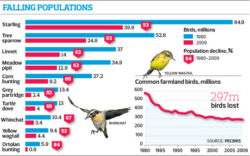North Americas bird population has declined by a third since 1970. This information is confirmed by researchers from several institutions. In 1970, experts estimated our breeding bird population to be around 10 billion individuals. In 2009, one research report published their results. The bird population was nearer 7 billion. A decline of 2.9 million birds had occurred in just 50 years.
Evolution and population change does happen but…that is a lot of lost birds. The decline is evident in endangered and common species. Junco’s, sparrows, Orioles, meadowlarks, swallows, finches, and warblers. Almost every bird species has shown a decline.
Birds, like many of Nature’s creatures are a measure of the health of our Ecosystems. If they become at risk, so will we. Since 2009, matters have only gotten worse.
There is no one primary reason for bird mortality but there are some big ones.
Wind Turbines and Towers These energy saving fans, and static obstacles, chew up millions of birds annually. It turns out that prime locations for wind farms are along bird migration routes. We need to make cheaper and simpler energy producers than the mammoth air and bird slicing beasts of today. The average wind turbine takes 25 years to pay for itself! Many towers and powerlines, also suspend wires that cause electrocutions and impact mortality. These structures account for over 50 million birds annually.
House Cats These bird predators spend much of their time stalking and killing birds and other small mammals. In most cases, they simply kill them and do not eat them. House cats need to be kept in the house. 15 million birds fall prey to cats and other predators each year.
Windows An estimated 988 million birds die from impacts with glass. These transparent barriers are invisible to birds. Many people hang plants in their windows, making the space look natural. Installing screens is helpful. Once you discover a window that seems to cause the most impacts, add tape, strings, or other visible materials to alert the birds of the danger.
Cars and vehicles also strike 60 million birds annually. This is especially true along roadways where the trees and plants are close and covering the highways. Interstates and larger, more open highways see less mortality of birds and other critters.
Plastics Birds, fish, and other creatures often eat on small pieces of plastics, that they mistake for food. Even as plastics break down, the chemicals and pieces are still dangerous. Shorebirds are especially impacted by small bits of plastic. Pick up and recycle plastics. Choose reusable items instead.
Pest Control Birds feast on many natural pests. When you spray chemicals to kill the pests, you often kill the rest of the critters in the area. Use environmentally safe products to do the job and keep the birds alive so they can help. Poisoning of bird’s accounts for over 72 million deaths annually.
Habitat With more development there is more asphalt, concrete, and less places for wildlife. Turn your lawn into a sanctuary for wildlife. Create islands and edges of native grasses, plants, and cover where critters and birds are invited to nest and survive. Using feeders is helpful in the Winter, but feed less when the birds need to target natural foods, like the insect pests in your yard.
Bird houses are nice but make sure to research the kinds of houses for which kind of birds. Maintain and clean them. Place them appropriately so that the immature hatchlings have a chance to survive after leaving their nests.
Everyone can do a small part to help our feathered friends. Teaching our children, the importance of birds and our Ecosystems is critical to maintaining them for the future.
Help to keep the flocks flying!
Montana Grant